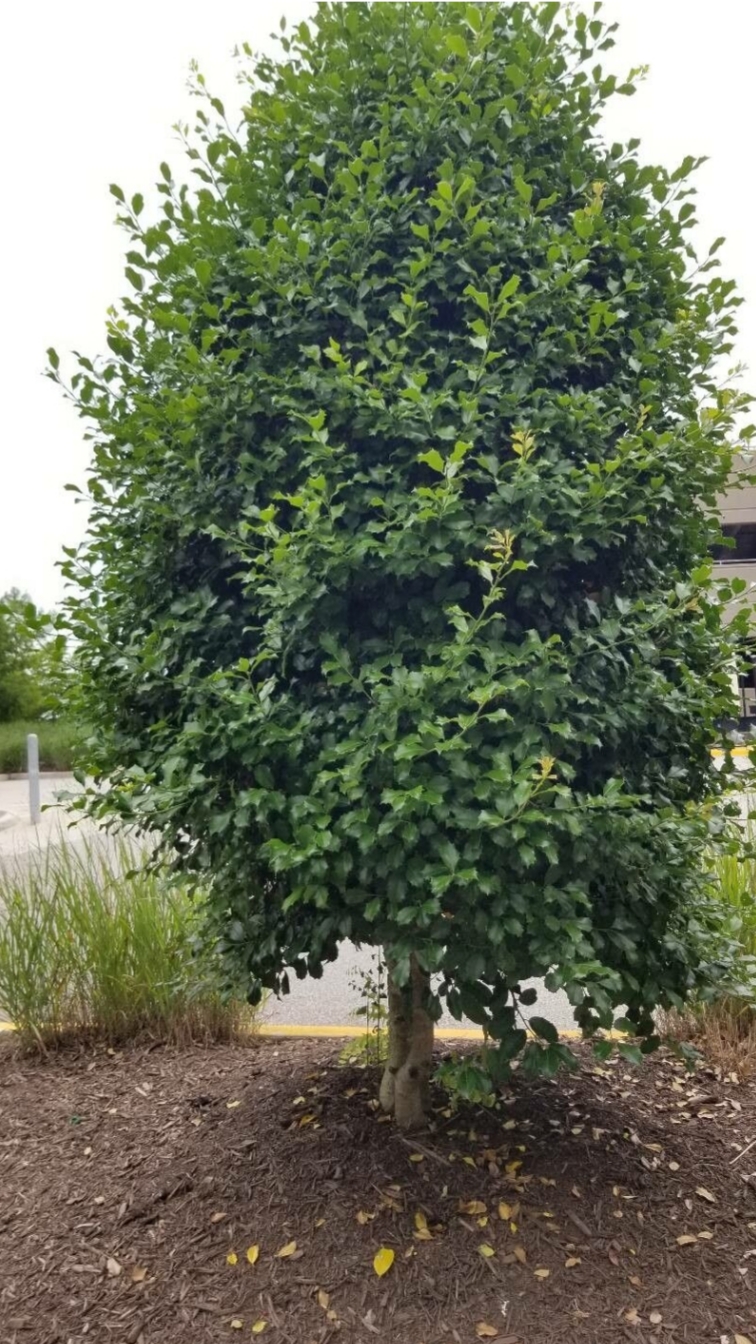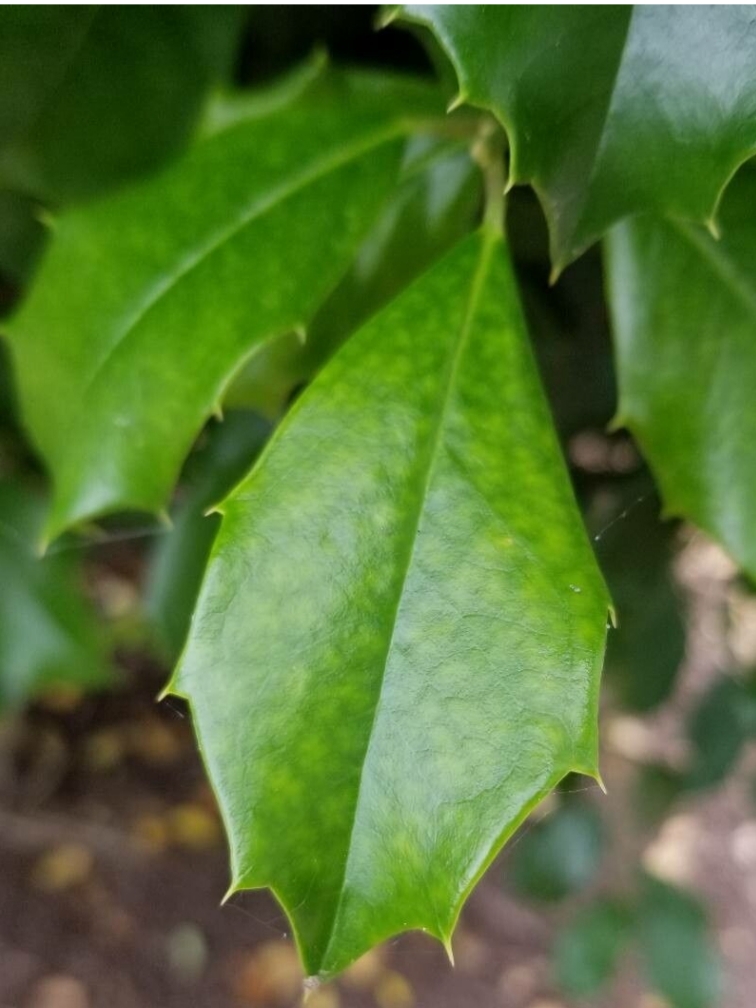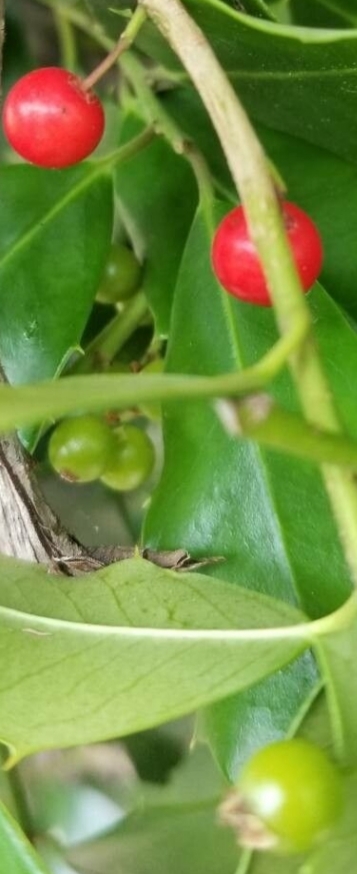Taxonomy
Family: Aquifoliaceae
Genus: Ilex
Species: Ilex opaca Aiton
Common names (Ilex opaca, n.d.; TWC Staff, 2015)
- American holly
- White Holly
- Prickly Holly
- Evergreen Holly
- Christmas Holly
- Yule Holly
Morphology
Type: broadleaf evergreen upright pyramidal (Ilex opaca, n.d.).
Size: Up to 9m in height in when cultivated, but can reach up to 15m in the wild with higher temperatures. With moister soil, American holly trees can even grow up to 30m (Ilex opaca, n.d.; TWC Staff, 2015).
Leaves: Thick and leathery green leaves up to 10 cm long. The leaves have marginal teeth (Ilex opaca, n.d.).
Flowers: It has greenish-white to cream colored small flowers that bloom from May to June. Both male and female flowers are in clusters on separate trees – each tree only has flowers of one sex (Ilex opaca, n.d.).
Fruit: It is a reddish-orange showy drupe (that looks like a berry) up to 1.3 cm. It is the matured ovary of the female flower. (Ilex opaca, n.d.; TWC Staff, 2015)
Growth and Attributes
Reproduction: requires male and female plants (TWC Staff, 2015). It requires a ratio of 3 females per each male plant to successfully produce fruit.
Pollinators: It is pollinated by Henry’s Elfin butterflies and honey bees (Ilex opaca, n.d.).
Habitat: shaded rich forest (under the canopy), bottom-lands, streams, rivers, swamp margins and coastal dunes (Ilex opaca, n.d.; TWC Staff, 2015)
Distribution: Eastern and central United States; see: USDA Distribution Map(Ilex opaca, n.d.).
Cultivation: Grows in full sun to partial shade. It can grow in a wide variety of soils as long as they are moist, well drained, and acidic. It can’t grow in saturated soils (ex. Clay soils) nor in soils with high pH. According to the soil pH, the leaf changes color – for ex., in alkaline soils, the leaves are yellow (Ilex opaca, n.d.; TWC Staff, 2015; American Holly, 2023).
Conservation status: Least concern (Ilex opaca, 2023)
Ecosystem value: feeds birds and small mammals, shelters nests, butterflies’ larvae and bees (Ilex opaca, n.d.; TWC Staff, 2015)
Human uses: ornamental, shade and hedges. The wood is used for several items including furniture (Ilex opaca, n.d.; TWC Staff, 2015)
Pests: holly leaf miner holly leaf miner leaf damage, mites, whitefly, and scale. Diseases include: leaf spot, American holly rust, leaf rot, tar spot*, black mildew and powdery mildew (Ilex opaca, n.d.; Pettis, 2021)
* The image of tar spot is not of an American Holly, but this disease is still common in that species and presents similarly.
Unique characteristics: Resistant to air pollution and clay soil. It is the only native U.S. holly with spiny green leaves and bright red drupes. Is slow growing.(Ilex opaca, n.d.; American Holly, 2023; TWC Staff, 2015)
Toxicity: It is toxic to humans and other animals if consumed (Ilex opaca, n.d.; American Holly, 2023; TWC Staff, 2015)
Resistant to deer? Yes
Wetland plant status: there are 2 wetland regions in VA:
- Mountains and Piedmonts – the American holly is Facultative upland (FACU) in the mountains and piedmonts regions
- Atlantic and Gulf Coastal Plain – the American holly is Facultative (FAC) for the Atlantic and Gulf Coastal Plain
Recommended Reading
Global Biodiversity Information Facility (GBIF) Listing
Digital Atlas of the Virginia Flonra Species Distribution Map
Native Trees and Shrubs for Pollinators
References
Ilex opaca. (2023, July 5th). In Wikipedia. https://en.wikipedia.org/wiki/Ilex_opaca
TWC Staff. (2015, November, 12). Ilex opaca Aiton. Ladybird Johnson Wildflower center. https://www.wildflower.org/plants/result.php?id_plant=ILOP
Ilex opaca. (n.d.). North Carolina Extension. https://plants.ces.ncsu.edu/plants/ilex-opaca/
Ilex opaca. (n.d.). Missouri Botanical Garden. https://www.missouribotanicalgarden.org/PlantFinder/PlantFinderDetails.aspx?kempercode=k640
Ilex opaca. (n.d.). U.S. Army Corps of Engineers. https://wetland-plants.sec.usace.army.mil/nwpl_static/v34/species/species.html?DET=001100#
USDA NRCS Plant Materials Program, (2002, Feb 5). Plant Fact Sheet American Holly Ilex opaca Ait. USDA NRCS. https://plants.usda.gov/DocumentLibrary/factsheet/pdf/fs_ilop.pdf
Yale Nature Walk, American Holly, 2023. Yale University. https://naturewalk.yale.edu/trees/aquifoliaceae/ilex-opaca/american-holly-91
Coauthored by Monica Marcelli & Adrian Hagarty, 2023.



